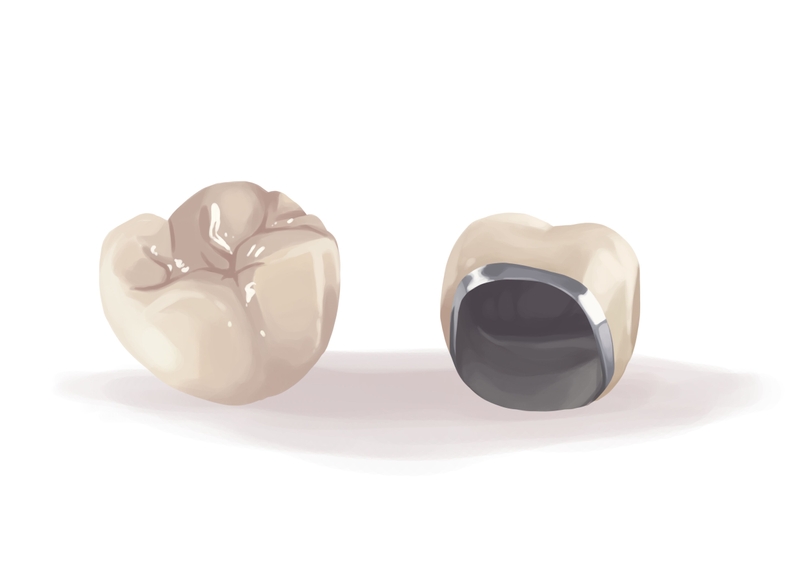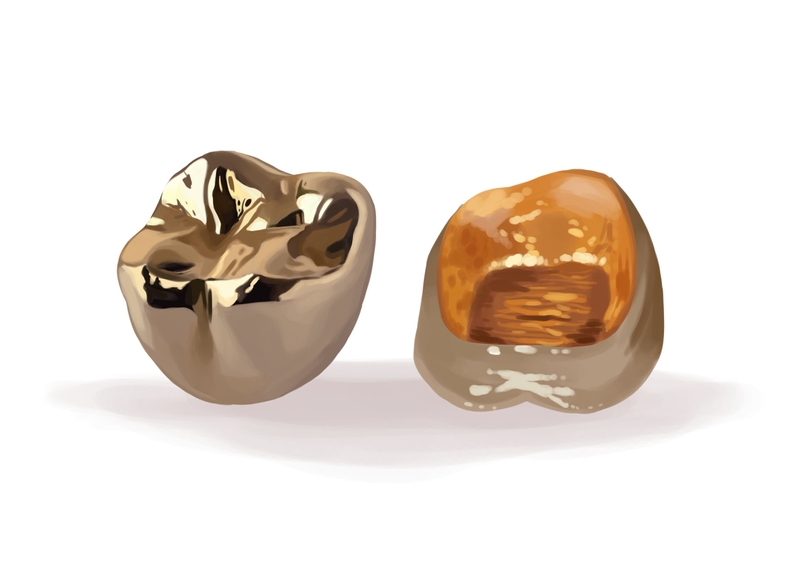- Dental crowns are tooth-shaped caps. They can be made of a variety of materials, including all-ceramic, zirconia, and porcelain-fused-to-metal.
- Crowns can be used for three reasons: to cover another treatment, for support, or for aesthetic reasons.
- Dental crowns can also be used to restore teeth that have had large fillings or root canal treatment. They can support dental bridges and teeth that are cracked, worn, or weakened by disease.
Need a new dental crown fast? Use Authority Dental to find and book a dentist open now near you. It’s simple, fast and free.
What type of dental crown should you choose? Here's everything you need to know.
When are crowns recommended?
There are three main reasons for getting a crown:
to cover up some other treatment,
for support, or
aesthetic reasons.
A crown may cover the tooth fully or partially up to the gumline. This, and the price for a dental crown, both depend on the condition and health of the existing dentition.
Crowns can restore teeth that have large fillings or root canal treatment and can be placed on top of dental implants. They may also support dental bridges and teeth that are cracked, worn down, or weakened by disease—all of these to protect the existing dentition and prevent further damage.
For aesthetic reasons, such a restoration can help alter the color, shape, or size of the tooth. If you want to change the appearance of the tooth, consider veneers instead.
Types of crowns
There are a few types of dental crowns. You can differentiate between them by the material they are made from.
All-ceramic

Picture by Authority Dental under CC 2.0 license
A dental crown made entirely of porcelain is referred to as “all-ceramic. Nowadays, it is the most popular crown type.
One of the most significant advantages is its aesthetic appeal. It can match the shape, size, and color of the surrounding dentition perfectly. That is why it is recommended as a front tooth crown and commonly performed by cosmetic dentists.
Porcelain is also biocompatible and toxin-free. This means it will not cause an allergic reaction, unlike metal crowns. The downside is that it is pretty pricey.
Lithium disilicate is one type of porcelain. Some clinics have equipment that allows them to make such crowns in-office. This means the crown does not need to be sent to the lab, which can save a lot of time.
Although it is the most expensive crown material, it is not the most durable. It can last a long time, but not quite as long as metal. What is more, it wears down the opposing tooth (the one it bites down on).
Great aesthetics
Lithium disilicate can be made in one visit
Biocompatible and toxic-free
Expensive
Not the most durable
Wear down opposing teeth
Often can’t be done in one appointment

Zirconia dental crowns

Picture by Authority Dental under CC 2.0 license
Zirconia crowns combine the strength of metal and the convincing appearance of porcelain. Those suffering from allergies can also safely choose this material. It is biocompatible, so it does not cause adverse reactions. Such crowns are becoming increasingly popular.
They can also be layered with porcelain to enhance their appearance further. If that is not done, it can be challenging to match the exact color of the surrounding teeth, as zirconia is very opaque.

Zirconia crowns can sometimes be milled at the dental office. This means it could be done in a single appointment or in a single day. You may not need a temporary crown. What is more, the material is very strong and requires less tooth preparation. It can be bonded or cemented, so the dentist has more options.
The downsides are that the material makes these crowns difficult to adjust, they are expensive, and they do wear down the tooth they bite on. That said, they are unlikely to wear down or chip.
Strong and durable
Can look great
Biocompatible and toxic-free
Sometimes can be done in one appointment
Less tooth preparation
Expensive
Difficult to adjust
Wear down opposing teeth
Lee explains: "For the back molars that endure the massive pressure of chewing and grinding, we need strength. This is where Zirconia has revolutionized my practice. It offers the durability of metal but is tooth-colored and biocompatible, making it the modern 'workhorse' of dentistry."
"That said, I still tell my patients that if aesthetics did not matter, gold would be the undefeated champion. It requires the least amount of drilling—preserving your natural tooth structure—and is gentle on the opposing teeth. Unfortunately, convincing a modern patient to choose a gold tooth is a tough sell," he adds.
Porcelain Fused to Metal Crowns (PFM)

Picture by Authority Dental under CC 2.0 license
Porcelain-fused-to-metal (PFM) means the crown has a metal base and a porcelain top. The porcelain top mimics the shape, size, and color of the surrounding teeth. It may not be the most popular, but it is widely used.
It is among the strongest and most durable, and less costly than an all-ceramic or zirconia crown. However, such a crown has drawbacks.
The biggest downside of PFM crowns is a gray line between the tooth and gum that is sometimes visible. What is more, if you are prone to clenching, it can chip or damage the opposing teeth. It can also cause allergic reactions.
This type of crown cannot be done in one visit, like some of the ones described above. You will have to wear a temporary one.
Shape, size, and color can be mimicked
Strong and durable
Less costly
Grey line between the tooth and gum
Can chip or damage opposing teeth
Cannot be done in one visit
Can cause allergies
Need more tooth reduction
All-metal crown

Picture by Authority Dental under CC 2.0 license
An all-metal crown is the strongest and most durable type, but it is not as aesthetically pleasing. While the shape and size of the surrounding teeth can be mimicked, the color remains different.
They are usually used for back tooth restoration. Some do, however, like this aesthetic and even go so far as to engrave it or add gems.
Unfortunately, all-metal crowns can cause allergic reactions. They are usually a mix of materials, including gold, chromium, palladium, and silver. The amount of gold in the crown can range from 20% to 77%.

Some ratings provide info on the metals used. The ratings are named “Base Metal”, “Noble Metal”, and “High Noble”. The last type has the highest gold content.
These crowns tend to be the best fitting and least damaging to opposing teeth.
The upside of these is that less of the tooth needs to be removed than with other materials, and they wear down at a rate similar to enamel. The downside is that they cannot be completed in one visit, and you do have to wear a temporary crown.
Strongest and most durable
Shape and size can be mimicked
Less of the tooth has to be removed
Wear down less than other types
Don’t wear down the opposing teeth very much
Cheaper than other options
Recommended for patients who grind
Not aesthetically pleasing
Can cause allergic reactions
Cannot be completed in one appointment

Provisional crown

Picture by Authority Dental under CC 2.0 license
A provisional crown is what you wear while you wait for your permanent crown. It can also be described as "temporary". It is made from materials that are not meant to last very long, and it is not permanently attached.
It shouldn't be worn for more than a few months to a year at most. Most of the time, it stays in the mouth for less than two weeks. The longer you wear it, the more problems it can cause.
A temporary crown is usually included in the price for the permanent crown. It is a necessary step if you have to leave the office before the permanent crown is ready, you could damage your living tooth.
Dental crown procedure
The tooth crown process can be divided into seven generalized steps. Some might not apply to every case. You will most likely have some sort of oral examination first, but after that, it usually takes a few weeks to get a permanent crown.
Preparation of the tooth
The tooth crown procedure begins with the removal of the decay, performing the root canal treatment if necessary, or both. The affected area will be numbed with a local anesthetic. The tooth will be shaved down as necessary.
Post and core buildup
You might need additional steps to build up your foundation, depending on the state of the tooth. The most common way is a post and core buildup. This is recommended for teeth that have suffered considerable decay. This step can sometimes be done at the same time as preparation or shaving of the tooth.
Making a mold or scanning the tooth with a digital device
An impression can be made to make sure the crown fits perfectly. Some dentists prefer to use a scanner instead of the unpleasant putty. The opposing tooth can also be recorded so that the bite is comfortable.
Determining the shade
This can be done by using a shade guide or taking pictures of the teeth. It will help the lab technician make crowns that will match the rest of your teeth. In some cases, the dentist may refer you to a ceramist for perfect shade selection.
Temporary dental crown
A provisional crown will be made from resin or acrylic. It will come off easily when it is time to place the permanent crown. During this time, be sure to avoid eating hard or sticky food, as the temporary crown can crack or fall off.
Crown fabrication
There might be a few weeks between placing the provisional crown and the next appointment.
Permanent crown placement
Lastly, the permanent crown will be placed and inspected for proper fit, bite, and smooth surface. Adjustments may need to be made, such as for the color or rough spots. Afterwards, the crown will be attached with cement or dental glue. This is permanent, and no more changes can be made.
FAQ
How long does a tooth crown last?
Longevity of crowns depends on the material they are made from, how well you take care of them, and their location. Porcelain crowns can last between 5 and 15 years, while PFM ones last about 20. The most durable are all-metal crowns, and they can last over 20 years up to a lifetime.
What does a dental crown look like?
How much tooth structure is needed for a crown?
How much tooth crown pain will I experience?
Since an anesthetic will be used to numb the dental crown pain, you should feel no more than slight discomfort during the procedure. It is common to experience tenderness in the gums surrounding the crown. This is because the dental cement can irritate them.
Pain in the tooth with the crown when biting down is completely normal. Treat this with OTC painkillers and keep the area clean. Toothpaste for sensitive teeth and gums is also a good idea. The unpleasant feeling will subside within a few days. The pain shouldn’t be severe or last for several weeks. If the tooth continues to hurt, make an appointment with your dentist. Sometimes a simple adjustment is enough to solve the problem.
Can your teeth rot under the crown?
How to fix a broken crown tooth?
Namrita Harchandani, DMD
Dental crowns are the best way to protect the original natural tooth. With the advancements in dental technology and materials, very realistic crowns can be made that will make you forget that you even have one.